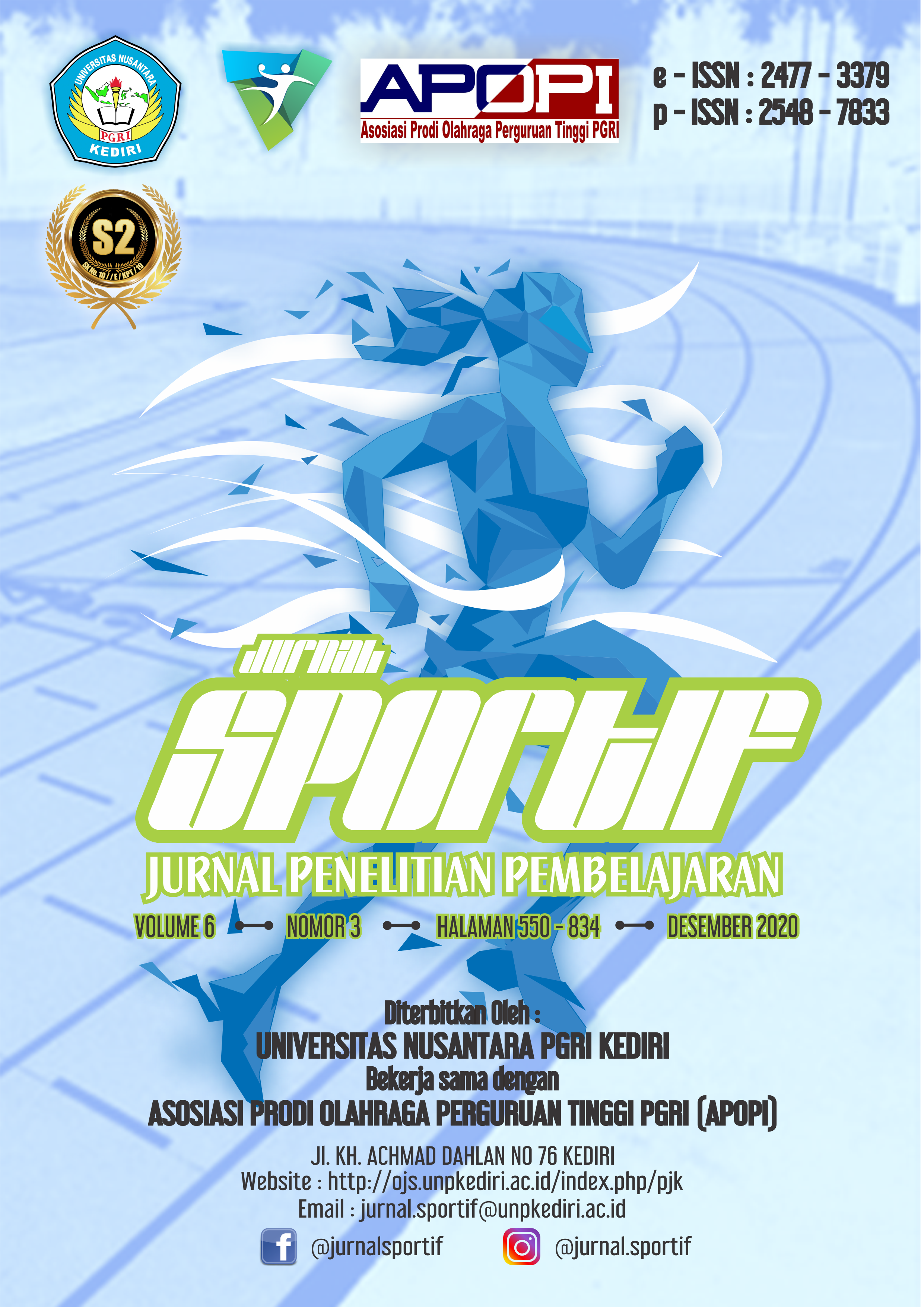Abstract
Tujuan dari penulisan review ini adalah untuk merangkum dan mengidentifikasi bukti-bukti penelitian secara deskriptif serta sistematis terkait dengan efektivitas dari mulligan mobilization with movement terhadap penurunan nyeri dan peningkatan fungsional pada penderita lateral epicondylitis. Metode penelitian yang digunakan adalah narrative review. Pencarian literature dilakukan pada database Google Scholar dan PubMed, dengan memasukkan kata kunci yang telah ditentukan sebelumnya, dan dari artikel penelitian yang didapatkan, selanjutnya dilakukan penilaian menggunakan form The Joanna Briggs Institute (JBI) Critical Appraisal Checklist untuk menilai kualitas atau grade dari artikel penelitian yang akan direview. Sebanyak 7 artikel penelitian didapatkan saat pencarian literature dengan klasifikasi 2 artikel berkualitas baik (Grade A) dan 5 artikel berkualitas cukup baik (Grade B). 5 dari 7 artikel melaporkan hasil yang signifikan terhadap penurunan nyeri, peningkatan fungsional dan grip strength. Kesimpulan dalam penelitian ini yaitu mulligan mobilization with movement merupakan intervensi yang terbukti efektif dalam penurunan nyeri, peningkatan fungsional dan grip strength pada penderita lateral epicondylitis.
References
Abbas, S., Riaz, R., Khan, A. A., Javed, A., & Raza, S. (2019). Effects of Mulligan and Cyriax Approach in Patients with Subacute Lateral Epicondylitis. The Rehabilitation Journal, 3(2), 107–115.
Afzal, M. W., Ahmad, A., Waqas, M. S., & Ahmad, U. (2016). Effectiveness of Therapeutic Ultrasound with and Without Mulligan Mobilzation in Lateral Epicondylitis. Annals of King Edward Medical University, 22(1), 47–59. https://doi.org/https://doi.org/10.21649/akemu.v22i1.798
Amro, A., Diener, I., Bdair, W. O., Hameda, I. M., Shalabi, A. I., & Ilyyan, D. I. (2010). The Effects of Mulligan Mobilisation with Movement and Taping Techniques on Pain, Grip Strength, and Function in Patients with Lateral Epicondylitis. Hong Kong Physiotherapy Journal, 28(1), 19–23. https://doi.org/https://doi.org/10.1016/j.hkpj.2010.11.004
Anap, D. B., Shende, M. L., & Khatri, S. (2012). Mobilization with Movement Technique as an Adjunct to Conventional Physiotherapy in Treatment of Chronic Lateral Epicondylits-A Comparative Study. Journal of Novel Physiotherapies, 2(7). https://doi.org/https://doi.org/10.4172/2165-7025.1000121
Arirachakaran, A., Sukthuayat, A., Sisayanarane, T., Laoratanavoraphong, S., Kanchanatawan, W., & Kongtharvonskul, J. (2016). Platelet-rich Plasma Versus Autologous Blood Versus Steroid Injection in Lateral Epicondylitis: Systematic Review and Network Meta-Analysis. Journal of Orthopaedics and Traumatology, 17, 101–112. https://doi.org/https://doi.org/10.1007/s10195-015-0376-5
Bagade, V. K., & Verma, C. (2015). Effect of Mulligan Mobilization with Movement (MWM) in the Treatment of Chronic Lateral Epicondylitis: 24 Weeks Follow-up Study. Indian Journal of Physiotherapy and Occupational Therapy, 9(4), 199–204. https://doi.org/http://dx.doi.org/10.5958/0973-5674.2015.00172.0
Brummel, J., & Hopkins, R. (2014). Epicondylitis: Lateral. Sports Medicine and Arthroscopy Review, 22(3), 1–6. https://doi.org/https://doi.org/10.1097/JSA.0000000000000024
Coombes, B. K., Bisset, L., & Vicenzino, B. (2015). Management of Lateral Elbow Tendinopathy: One Size Does Not Fit All. Journal of Orthopaedic & Sports Physical Therapy, 45(11), 938–949. https://doi.org/https://www.jospt.org/doi/10.2519/jospt.2015.5841
Dasm, P. G. (2012). Comparative Analysis of Cyriax Approach Versus Mobilization with Movement Approach in the Treatment of Patients with Lateral Epicondylitis. Indian Journal of Physiotherapy and Occupational Therapy, 6(1), 96–102.
Hariharasudhan, R., & Balamurugan, J. (2015). Effectiveness of Muscle Energy Technique and Mulligan’s Movement with Mobilization in the Management of Lateral Epicondylalgia. Archives of Medicine and Health Sciences, 3(2), 198–202. https://doi.org/https://doi.org/10.4103/2321-4848.171904
Janikowska, K., & Fidut, J. (2013). The Role of Mulligan Therapy Concept in Treatment of “Tennis Elbow” Symptoms. New Approaches in Joints Pain, 20–34.
Kwapisz, A., Prabhakar, S., Compagnoni, R., Sibilska, A., & Randelli, P. (2018). Platelet-Rich Plasma for Elbow Pathologies: a Descriptive Review of Current Literature. Current Reviews in Musculoskeletal Medicine, 11(4), 598–606. https://doi.org/https://doi.org/10.1007/s12178-018-9520-1
Mani, P., Sethupathy, K., & Habib, H. (2017). Comparison of Effectiveness of Movement with Mobilization Using Belt and Therapeutic Eccentric Exercise in Patients with Chronic Lateral Epicondylitis : A Randomized Clinical Trial. International Journal of Health Sciences and Research, 7(5), 144–150.
Patel, N. (2013). Effectiveness of Mobilization with Movement of Elbow Compared with Manipulation of Wrist in Patients of Lateral Epicondylitis. International Journal of Physiotherapy and Research, 1(4), 177–182.
Rahman, H., Chaturvedi, P. A., Apparao, P., & Srithulasi, P. R. (2016). Effectiveness of Mulligan Mobilisation with Movement Compared to Supervised Exercise Program in Subjects with Lateral Epicondylitis. Nternational Journal of Physiotherapy and Research, 4(2), 1394–1400. https://doi.org/https://doi.org/10.16965/IJPR.2016.104
Shiri, R., & Viikari-Juntura, E. (2011). Lateral and Medial Epicondylitis: Role of Occupational Factors. Best Practice & Research Clinical Rheumatology, 25(1), 43–57. https://doi.org/https://doi.org/10.1016/j.berh.2011.01.013
Welsh, P. (2018). Tendon Neuroplastic Training for Lateral Elbow Tendinopathy: 2 Case Reports. The Journal of the Canadian Chiropractic Association, 62(2), 98–104.
Authors who publish with this journal agree to the following terms:
- Copyright on any article is retained by the author(s).
- The author grants the journal, the right of first publication with the work simultaneously licensed under a Creative Commons Attribution License that allows others to share the work with an acknowledgment of the work’s authorship and initial publication in this journal.
- Authors are able to enter into separate, additional contractual arrangements for the non-exclusive distribution of the journal’s published version of the work (e.g., post it to an institutional repository or publish it in a book), with an acknowledgment of its initial publication in this journal.
- Authors are permitted and encouraged to post their work online (e.g., in institutional repositories or on their website) prior to and during the submission process, as it can lead to productive exchanges, as well as earlier and greater citation of published work.
- The article and any associated published material is distributed under the Creative Commons Attribution-ShareAlike 4.0 International License





